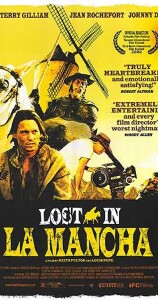 Terry Gilliam has wanted to make a film of Cervantes’ Don Quixote for at least 10 years, and in the summer of 2002 he finally got his chance. Plagued by the specter of one of the biggest debacles in recent film history, The Adventures of Baron Munchausen, he was finally able to put together European financing for a low-budget treatment of the film, to be shot on location in Spain.
Terry Gilliam has wanted to make a film of Cervantes’ Don Quixote for at least 10 years, and in the summer of 2002 he finally got his chance. Plagued by the specter of one of the biggest debacles in recent film history, The Adventures of Baron Munchausen, he was finally able to put together European financing for a low-budget treatment of the film, to be shot on location in Spain.
Documentarians Keith Fulton and Louis Pepe were filming the action for a “making-of” feature that would eventually be included in the DVD. So they were there, from the early production meetings until the end, as the project disintegrated in slow-motion agony.
Gilliam’s film was to be titled “The Man Who Killed Don Quixote,” and would feature Johnny Depp as a hapless American bureaucrat who somehow time-travels back to late-Medieval Spain, where he becomes Quixote’s sidekick, Sancho Panza. Veteran French actor Jean Rochefort was masterfully cast as Quixote.
We join the story some eight weeks before production is to start, in the pre-production meetings with the producers and crew. Because of the tight budget, the major actors have agreed to work for less than their usual scale, and are fitting this project in between other jobs. In the meantime, Gilliam works with his props, set, special effects and wardrobe people, and lays out an elaborate storyboard in his own delightful cartoons.
Some of the best scenes in the entire film come as Gilliam and crew do a screen test on three locals who will play the giants seen by Quixote in the famous windmill scene. These three hefty Spaniards gamely doff their shirts and run over hills and down roads behind track-mounted cameras, their fatty bellies and breasts jiggling, mugging like the hungry ogres they are in Quixote’s deluded imagination.
The remainder of the film depicts the hopeful beginning and rapid end to filming, as one disaster after another befalls the production. A thunderstorm of biblical proportions cuts short the second day of filming and sets production back by several days, and by the time they’re able to begin again, Rochefort has developed health problems that remove him from the set for days that become weeks.
There’s an emblematic scene where Depp gamely tries to film a scene with the beautiful horse cast as Rosinante, as the 30 or so European financial backers wander through the set taking snapshots. Otherwise, the camera spends a lot of time in seemingly endless meetings with crew, producers and financiers, and things drag toward the end of the documentary.
This film, at about 90 minutes, feels a bit long. Jeff Bridges does a fine job of narration, and Gilliam was extraordinarily generous to allow the film to be made at all. From the few scenes that were filmed, “The Man Who Killed Don Quixote” had a lot of potential. Lost in La Mancha is an illuminating look into the world of filmmaking, warts and all — a fascinating, but hardly essential, footnote in the history of cinema.
(Low Key Productions, A&E Home Video, 2002)
